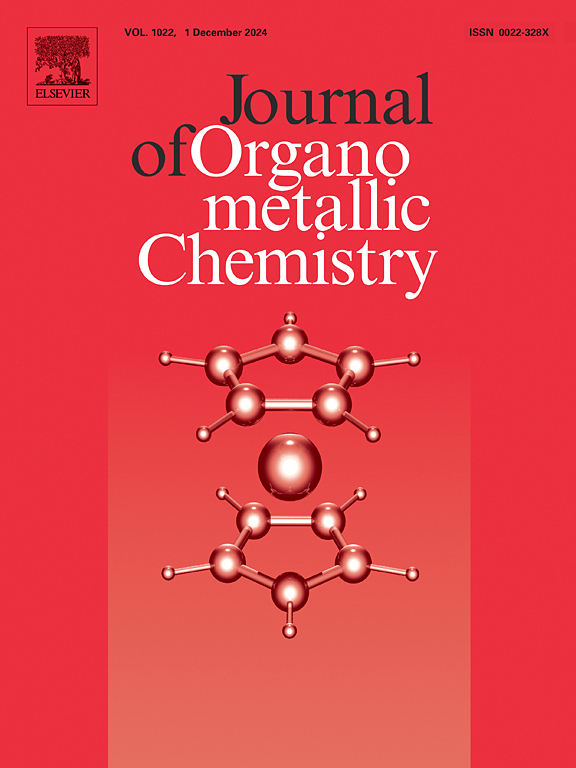新型枝晶镍配合物:乙烯的合成、表征及低聚化性能
IF 2.1
3区 化学
Q3 CHEMISTRY, INORGANIC & NUCLEAR
引用次数: 0
摘要
以1.0代树突状多胺(1.0 g)、水杨醛和无水氯化镍为原料,通过席夫碱形成和络合反应合成了两种新型树突状镍配合物。采用FT-IR、¹H NMR、ESI-MS和元素分析等手段对树状配体及其相应的镍配合物的结构进行了表征。这些树枝状镍配合物在共催化剂(包括EtAlCl₂,et2alcl, AlEt₃和IBAL)的存在下被评价为乙烯低聚化的催化剂前体。其中,新型枝晶镍配合物(预催化剂)与Et₂AlCl(助催化剂)的组合表现出显著的催化性能。系统考察了Al/Ni摩尔比、温度、乙烯压力等关键反应参数对低聚反应效率的影响。两种枝状镍配合物的催化活性分别为:5-溴水杨醛(5Br-cat)和3,5-二溴水杨醛(3,5br-cat),分别为9.44 × 10 5 g/(mol Ni·h)和7.34 × 10 5 g/(mol Ni·h)。结果表明,助催化剂的性质和镍配合物的结构特征对催化活性和产物分布都有很大的影响。值得注意的是,枝晶镍配合物的催化活性随着分支结构中位阻的增加而降低。本文章由计算机程序翻译,如有差异,请以英文原文为准。
Novel dendritic nickel complexes: Synthesis, characterization and oligomerization properties of ethylene
Two novel dendritic nickel complexes were synthesized via Schiff base formation and complexation reactions using 1.0-generation dendritic polyamine (1.0 g), salicylaldehyde, and anhydrous nickel chloride. The structures of the dendritic ligands and their corresponding nickel complexes were characterized using FT-IR, ¹H NMR, ESI-MS, and elemental analysis.These dendritic nickel complexes were evaluated as catalyst precursors for ethylene oligomerization in the presence of co-catalysts, including EtAlCl₂, Et₂AlCl, AlEt₃, and IBAL. Among them, the combination of the new dendritic nickel complex (as the pre-catalyst) and Et₂AlCl (as the co-catalyst) exhibited notable catalytic performance. The effects of key reaction parameters—such as the Al/Ni molar ratio, temperature, and ethylene pressure—on oligomerization efficiency were systematically investigated.The catalytic activities of the two dendritic nickel complexes, featuring 5-bromosalicylaldehyde (5Br-cat) and 3,5-dibromosalicylaldehyde (3,5br-cat) in their branch chains, were determined to be 9.44 × 10⁵ g/(mol Ni·h) and 7.34 × 10⁵ g/(mol Ni·h), respectively. The results indicate that both catalytic activity and product distribution are strongly influenced by the nature of the co-catalyst and the structural features of the nickel complex. Notably, the catalytic activity of the dendritic nickel complex decreases with increasing steric hindrance in the branching structure.
求助全文
通过发布文献求助,成功后即可免费获取论文全文。
去求助
来源期刊

Journal of Organometallic Chemistry
化学-无机化学与核化学
CiteScore
4.40
自引率
8.70%
发文量
221
审稿时长
36 days
期刊介绍:
The Journal of Organometallic Chemistry targets original papers dealing with theoretical aspects, structural chemistry, synthesis, physical and chemical properties (including reaction mechanisms), and practical applications of organometallic compounds.
Organometallic compounds are defined as compounds that contain metal - carbon bonds. The term metal includes all alkali and alkaline earth metals, all transition metals and the lanthanides and actinides in the Periodic Table. Metalloids including the elements in Group 13 and the heavier members of the Groups 14 - 16 are also included. The term chemistry includes syntheses, characterizations and reaction chemistry of all such compounds. Research reports based on use of organometallic complexes in bioorganometallic chemistry, medicine, material sciences, homogeneous catalysis and energy conversion are also welcome.
The scope of the journal has been enlarged to encompass important research on organometallic complexes in bioorganometallic chemistry and material sciences, and of heavier main group elements in organometallic chemistry. The journal also publishes review articles, short communications and notes.
 求助内容:
求助内容: 应助结果提醒方式:
应助结果提醒方式:


